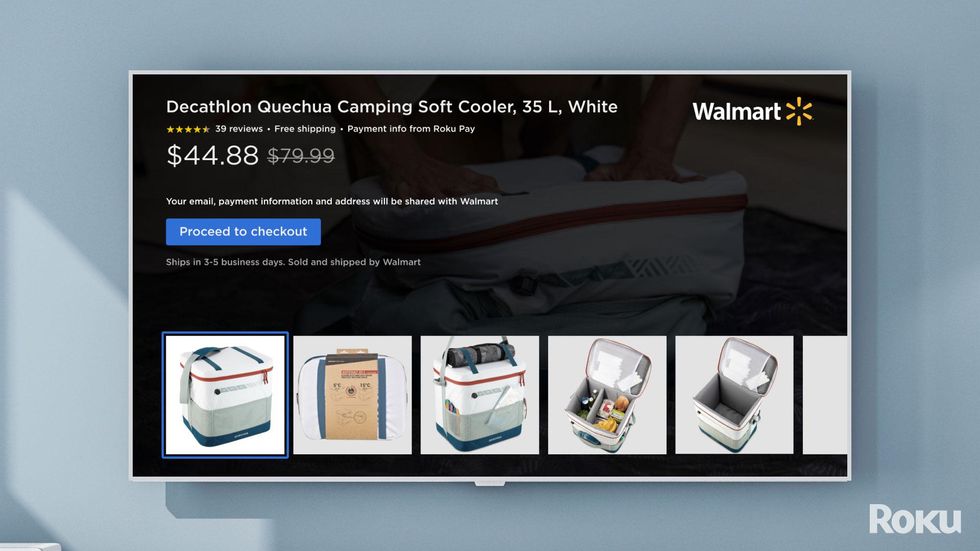Retail Channels
17 June 2022
eBay, Walmart and Roku are mixing entertainment and commerce
Plus, Walmart is bringing fulfillment tech to the store, and Meta's designer digital clothes.

(Illustration by The Current)
Plus, Walmart is bringing fulfillment tech to the store, and Meta's designer digital clothes.

(Illustration by The Current)
Welcome to Near Future. In this weekly feature, The Current spotlights innovations powering the next wave of commerce.
With Stores are becoming part of ecommerce, while video is getting more shoppable.
It’s all part of the evolution of ecommerce taking place through betas, pilots and tests being conducted by brands and retailers.
Here are a few forward-looking initiatives that caught our eye this week:
Walmart is making brick-and-mortar stores a key piece of its ecommerce strategy.
It might sound like a paradox, but details the retailer released this week about a store in Toronto help the strategy make sense.
Walmart said space inside a Walmart store just outside Toronto in Scarborough, Ontario, was recently repurposed with technology designed for order fulfillment. Working side-by-side with automated technology and proprietary Walmart systems, about 200 associates will support fulfillment of grocery orders and pickup from the store.
This allows the associates to pick items for online grocery orders six times faster than they would on a regular sales floor. One of the advantages is tighter inventory control, Walmart said. This results in fewer substitutions, and automated processes. The system also uses data to manage the freshness of items that will be selected.
Though they are being installed at a single store, the introduction of these systems will help with scale. According to Walmart, it can now fill 1,200 grocery orders a day at the site. Further, more than 70% of downtown Toronto customers could have online grocery deliveries fulfilled through the store. The company said it will also be able to reach customers in underserved areas from the store, as well.
"We've embraced technology to help us increase capacity for orders, providing our customers with more available timeslots and expanded access to delivery," said Walmart Canada Chief Ecommerce Officer Laurent Duray, in a statement. "Our associates and our stores are the key to the journey we're on to keep making the online shopping experience better and faster for our customers."
Outfitting stores with fulfillment technology is part of a C$3.5 billion investment that Walmart is making in infrastructure and shopper experience for ecommerce. In the US, it has a network of 4,700 stores which can be put to work as part of the ecommerce strategy. Walmart Chief Ecommerce Officer Tom Ward told CNBC recently that 75% of the company’s stores currently fulfill ecommerce orders, and it is making upgrades in those stores, as well.
The renovation of a segment of the Toronto store to reach a wide area fits into a less-is-more strategy that is beginning to emerge as Walmart rolls out details of its ecommerce upgrades. Earlier this month, the company announced the upcoming construction of four new fulfillment centers that will enable it to reach 75% of the US population via same-day or two-day delivery.
For Walmart, stores, regional distribution centers and larger fulfillment centers are all working together toward ecommerce.

A shoppable streaming ad. (Courtesy photo)
Walmart is also one half of a partnership that’s bringing ecommerce to streaming TV.
In a blend of entertainment and commerce, the retailer is partnering with Roku to make TV ads on the streaming service shoppable.
Here’s how it works:
Roku previously teased such a service at this year’s Newfronts advertising event. With the partnership, Walmart is the exclusive retailer making products available on Roku. Walmart will handle all fulfillment of these items. Roku is putting its advertising technology, called OneView, to work with this partnership for targeting and measurement.
Walmart and Roku say that the experience seeks to go beyond QR codes. Instead of scanning a code that brings a checkout page up on a mobile phone, the buying experience remains on the TV screen.
“We’re working to connect with customers where they are already spending time, shortening the distance from discovery and inspiration to purchase,” William White, chief marketing officer at Walmart, said in a statement. “No one has cracked the code around video shoppability. By working with Roku, we’re the first to market retailer to bring customers a new shoppable experience and seamless checkout on the largest screen in their homes – their TV.”
It comes as commerce is increasingly being embedded into digital spaces where people gather. Long a home of advertising for brands, a host of social media platforms are now adding in-app shopping and brand storefronts. TV, of course, is no stranger to advertising. Instead of using a remote to change the channel when an ad comes on, this feature holds the promise of clicking "buy" on an ad, instead.
Following this initial pilot, the companies said they are planning to introduce “deeper commerce experiences that meet customers where they are.”

eBay Live is starting with trading cards. (Courtesy photo)
Looking to translate success in China to the North American market, ecommerce marketplaces are continuing to integrate live shopping capabilities into their experiences. It's another way ecommerce and entertainment are blending.
The latest example comes from eBay, which is launching a new platform for live shopping that’s dedicated to trading cards and collectibles.
The eBay Live app, which is currently in beta, allows shoppers to interact directly with hosts through chat and reaction buttons. Meanwhile, it has functionality to make it possible to purchase items shown on a livestream.
The first event to take place on the platform will offer a curated selection of trading cards from top eBay seller Bleecker Trading, and will be hosted by trading card enthusiast DJ Skee. It is set to begin at 3 p.m. EST on June 22.
Designer duds in the metaverse. (Courtesy of Meta)
Just before the week was out, Meta announced a new way to shop for designer brands to style your digital likeness. Here's the announcement from CEO Mark Zuckerberg:
The Avatars Store will be rolling out in the next week Facebook, Instagram, and Messenger so you can buy digital clothes to style your avatar. Digital goods will be an important way to express yourself in the metaverse and a big driver of the creative economy. I'm excited to add more brands and bring this to VR soon too.
Zuckerberg shared that designers that looks from designers Balenciaga, Prada, and Thom Browne will be available. It's one sign of how the metaverse will offer a whole new way to shop. Just like shoppers outfit themselves and buy goods IRL, the groundwork for digital buying is being laid now.
New advertising opportunities are being beta tested for in-store audio and product demos.
Retail media’s fast growth isn’t only limited to increasing spend. The advertising itself is also poised to appear in more places beyond ecommerce marketplaces, and even beyond the web.
The latest example comes from Walmart Connect, which is the retail media arm of the world’s largest retailer.
Walmart shared details on testing that it is completing for in-store retail media. To this point, Walmart Connect has been considered the advertising platform for Walmart’s ecommerce site. But these tests indicate that’s poised to expand.
Stores present a potent opportunity for Walmart. It has 4,700 big box locations around the U.S., and customers returned to them in droves last year. In 2022, 88% of the retailer’s customers visited Walmart stores.
Walmart Connect already has already dipped a toe into in-store advertising, with a TV wall, self-checkout ads and integrated marketing. The new pilots aim to take a step further.
“The next frontier of retail media is in-store experiences, and it’s one we’re excited to chart,” Whitney Cooper, head of omnichannel transformation at Walmart Connect, wrote in a blog post on the new tests. “But it’s still an emerging opportunity for us, as we continue to test what serves customers best and which solutions are scalable to Walmart’s size.”
Here’s a look at the two new offerings currently under beta test:
Walmart suppliers will be able to integrate product demos into campaigns across in-store and digital environments.
Product demos aren’t new to store floors, but Walmart Connect is seeking to give them an update that blends digital and physical experiences.
“Part of our test is how to enhance the omnichannel experience by bridging the physical back to digital: For example, by pairing a demo cart with QR codes that link back to a curated Walmart.com landing page so customers can find inspiration and shop their list all in one spot,” Cooper wrote.
Walmart is currently offering 120 demos at stores each weekend, and plans to scale to 1,000 by the end of 2023.
Walmart Connect will now offer advertising placements on Walmart’s in-store radio network. Suppliers will have the option to purchase ads by region or store, enabling targeting of key markets.
“This is the first time brands will be able to speak directly to Walmart customers through this medium,” Cooper writes. “These ads also create a new upper-funnel touchpoint for brand marketers and out-of-home (OOH) buyers to create awareness, because in-store audio is about connecting with customers wherever they are in the store — they don’t have to pass the brand in the aisle.”
With the tests, we’ll be watching for how this advertising is measured, and whether Walmart Connect is tracking impact across different types of formats, and not just a single campaign.